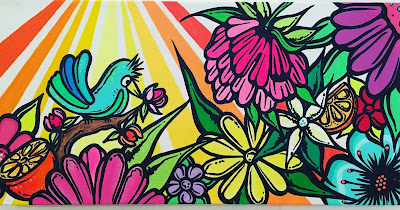We are very excited to have on loan from the Mario Cader-Frech Collection the artist film- La Barrida. Now showing through October 25. Introduced to us by curator Clair Breukel, from Yes Contemporary
Veronica Vides
La Barrida
Video
Duration: 3 mins
On loan from the Mario Cader-Frech Collection
La Barrida
Video
Duration: 3 mins
On loan from the Mario Cader-Frech Collection
“La Barrida” depicts a group of twenty
ex-combatants, each of whom suffered immense hardship during the Salvadoran
Civil War (1979-1991), sweeping the ruins of the Aguacayo church. The church is
in ruins, and is one of many living examples of the destruction caused by armed
conflict in the country. The video proposes that the activity of cleaning could
somehow improve the situation, but in the end the action only serves to
absurdly multiply the dirt, adding to the burden.
Verónica Vides
La Barrida
Video
Duración: 3 minutos
Préstamo de la Colección Mario Cader-Frech
La Barrida
Video
Duración: 3 minutos
Préstamo de la Colección Mario Cader-Frech
"La
Barrida" representa a un grupo de veinte excombatientes, cada uno de los
cuales sufrió enormes dificultades durante la Guerra Civil Salvadoreña
(1979-1991), barriendo las ruinas de la iglesia de Aguacayo. La iglesia está en
ruinas, y es uno de los muchos ejemplos vivientes de la destrucción causada por
el conflicto armado en el país. El video propone que la actividad de limpieza
podría de alguna manera mejorar la situación, pero al final la acción solo sirve
para multiplicar absurdamente la suciedad, lo que aumenta la carga.
Verónica
Vides (El Salvador, 1970)
Veronica
Vides is a Salvadoran artist with a background in Graphic Design. An early
accolade included winning first place at the JUANNIO art contest in Guatemala
in 2003. That same year she was invited to participate in Arte Paiz Biennial
and HABITART in El Salvador. In 2004, Vides received honorable mention at the
IV Central American Biennial, and in 2010 was selected to participate in the
1st Triennial of the Caribbean, Dominican Republic as well as the VII Central
American Biennial. In 2011, Vides participated in CHANGE at the World Bank in
Washington, D.C., USA , and in 2014 was awarded the Honor Prize at Salón Artes
Plásticas in Esquel, Argentina. In 2016 she participated in the Plan de Evasion
residency at the Tunca Foundation, and the X Biennial of Central America in
Costa Rica. In 2018, Vides participated in the exhibition Donde hubo
fuego… at Museum of Art in El Salvador (MARTE).
Her
artwork is part of many public collections, including: Ministerio Relaciones
Exteriores, México; World Bank, USA; MADC and TEOR/éTica in Costa Rica; Museum
of Art in El Salvador Collection; and the Ortiz Gurdián Foundation Collection,
Nicaragua. Currently, she lives and works in Patagonia, Argentina.
Verónica
Vides (El Salvador, 1970)
Verónica
Vides es una artista Salvadoreña con experiencia en Diseño Gráfico. Uno de los
primeros galardones que recibió fue ganar el primer lugar en el concurso
de arte JUANNIO en Guatemala en 2003. Ese mismo año fue invitada a participar
en la Bienal Arte Paiz y HABITART en El Salvador. En 2004, Vides recibió
mención honorífica en la IV Bienal Centroamericana, y en 2010 fue seleccionado
para participar en la 1ra Trienal del Caribe, República Dominicana, así como en
la VII Bienal Centroamericana. En 2011, Vides participó en CHANGE en el Banco
Mundial en Washington, D.C., EE. UU., Y en 2014 recibió el Premio de Honor en
Salón Artes Plásticas en Esquel, Argentina. En 2016 participó en la residencia
Plan de Evasion en la Fundación Tunca y en la X Bienal de América Central en
Costa Rica. En 2018, Vides participó en la exposición Donde hubo fuego...
en el Museo de Arte de El Salvador (MARTE).
Su
obra de arte es parte de muchas colecciones públicas, entre ellas: Ministerio
Relaciones Exteriores, México; Banco Mundial, Estados Unidos; MADC y TEOR /
éTica en Costa Rica; Museo de Arte en la Colección El Salvador; y la Colección
de la Fundación Ortiz Gurdián, Nicaragua. Actualmente, ella vive y trabaja en
la Patagonia, Argentina.








